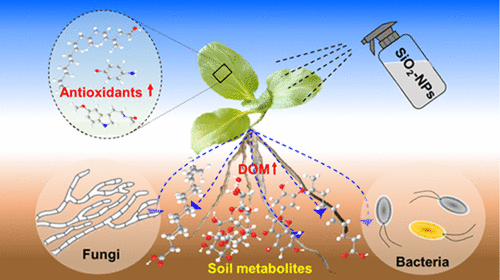当前位置:
X-MOL 学术
›
Environ. Sci. Technol.
›
论文详情
Our official English website, www.x-mol.net, welcomes your
feedback! (Note: you will need to create a separate account there.)
Foliar Application of SiO2 Nanoparticles Alters Soil Metabolite Profiles and Microbial Community Composition in the Pakchoi (Brassica chinensis L.) Rhizosphere Grown in Contaminated Mine Soil.
Environmental Science & Technology ( IF 10.8 ) Pub Date : 2020-09-20 , DOI: 10.1021/acs.est.0c03767 Liyan Tian 1 , Jupei Shen 2 , Guoxin Sun 2 , Bin Wang 1 , Rong Ji 1 , Lijuan Zhao 1
Environmental Science & Technology ( IF 10.8 ) Pub Date : 2020-09-20 , DOI: 10.1021/acs.est.0c03767 Liyan Tian 1 , Jupei Shen 2 , Guoxin Sun 2 , Bin Wang 1 , Rong Ji 1 , Lijuan Zhao 1
Affiliation

|
Silica nanoparticles (SiO2-NPs) are promising in nanoenabled agriculture due to their large surface area and biocompatible properties. Understanding the fundamental interaction between SiO2-NPs and plants is important for their sustainable use. Here, 3 week-old pakchoi (Brassica chinensis L.) plants were sprayed with SiO2-NPs every 3 days for 15 days (5 mg of SiO2-NPs per plant), after which the phenotypes, biochemical properties, and molecular responses of the plants were evaluated. The changes in rhizosphere metabolites were characterized by gas chromatography–mass spectrometry (GC–MS)-based metabolomics, and the response of soil microorganisms to the SiO2-NPs were characterized by high-throughput bacterial 16S rRNA and fungal internal transcribed spacer (ITS) gene sequencing. The results showed that the SiO2-NP spray had no adverse effects on photosynthesis of pakchoi plants nor on their biomass. However, the rhizosphere metabolite profile was remarkably altered upon foliar exposure to SiO2-NPs. Significant increases in the relative abundance of several metabolites, including sugars and sugar alcohols (1.3–9.3-fold), fatty acids (1.5–18.0-fold), and small organic acids (1.5–66.9-fold), and significant decreases in the amino acid levels (60–100%) indicated the altered carbon and nitrogen pool in the rhizosphere. Although the community structure was unchanged, several bacterial (Rhodobacteraceae and Paenibacillus) and fungal (Chaetomium) genera in the rhizosphere involved in carbon and nitrogen cycles were increased. Our results provide novel insights into the environmental effects of SiO2-NPs and point out that foliar application of NPs can alter the soil metabolite profile.
中文翻译:

SiO2纳米颗粒的叶面施用改变了受污染矿井土壤中小白菜根际土壤代谢产物的分布和微生物群落组成。
二氧化硅纳米颗粒(SiO 2 -NPs)由于具有较大的表面积和生物相容性,因此在纳米农业中很有前途。了解SiO 2 -NP与植物之间的基本相互作用对于其可持续利用非常重要。在这里,每3天给3周龄的小白菜(Brassica chinensis L.)植物喷洒SiO 2 -NP,持续15天(每株植物5 mg SiO 2 -NPs),然后对其表型,生化特性和分子响应进行分析。对其中的植物进行了评估。通过基于气相色谱-质谱(GC-MS)的代谢组学以及土壤微生物对SiO 2的响应来表征根际代谢物的变化-NPs的特点是高通量细菌16S rRNA和真菌内部转录间隔物(ITS)基因测序。结果表明,SiO 2 -NP喷雾对小白菜的光合作用和生物量均无不利影响。然而,叶面暴露于SiO 2 -NPs后,根际代谢产物的分布发生了显着变化。几种代谢物的相对丰度显着增加,包括糖和糖醇(1.3–9.3倍),脂肪酸(1.5–18.0倍)和小有机酸(1.5–66.9倍),而代谢产物的显着降低。氨基酸水平(60–100%)表明根际中碳和氮库的变化。尽管群落结构没有改变,但有几种细菌(红杆菌科和Paenibacillus)和根际中的真菌(Chaetomium)属参与了碳和氮的循环。我们的结果提供了对SiO 2 -NPs的环境影响的新见解,并指出叶面施用NPs可以改变土壤代谢产物的分布。
更新日期:2020-10-21
中文翻译:

SiO2纳米颗粒的叶面施用改变了受污染矿井土壤中小白菜根际土壤代谢产物的分布和微生物群落组成。
二氧化硅纳米颗粒(SiO 2 -NPs)由于具有较大的表面积和生物相容性,因此在纳米农业中很有前途。了解SiO 2 -NP与植物之间的基本相互作用对于其可持续利用非常重要。在这里,每3天给3周龄的小白菜(Brassica chinensis L.)植物喷洒SiO 2 -NP,持续15天(每株植物5 mg SiO 2 -NPs),然后对其表型,生化特性和分子响应进行分析。对其中的植物进行了评估。通过基于气相色谱-质谱(GC-MS)的代谢组学以及土壤微生物对SiO 2的响应来表征根际代谢物的变化-NPs的特点是高通量细菌16S rRNA和真菌内部转录间隔物(ITS)基因测序。结果表明,SiO 2 -NP喷雾对小白菜的光合作用和生物量均无不利影响。然而,叶面暴露于SiO 2 -NPs后,根际代谢产物的分布发生了显着变化。几种代谢物的相对丰度显着增加,包括糖和糖醇(1.3–9.3倍),脂肪酸(1.5–18.0倍)和小有机酸(1.5–66.9倍),而代谢产物的显着降低。氨基酸水平(60–100%)表明根际中碳和氮库的变化。尽管群落结构没有改变,但有几种细菌(红杆菌科和Paenibacillus)和根际中的真菌(Chaetomium)属参与了碳和氮的循环。我们的结果提供了对SiO 2 -NPs的环境影响的新见解,并指出叶面施用NPs可以改变土壤代谢产物的分布。











































 京公网安备 11010802027423号
京公网安备 11010802027423号